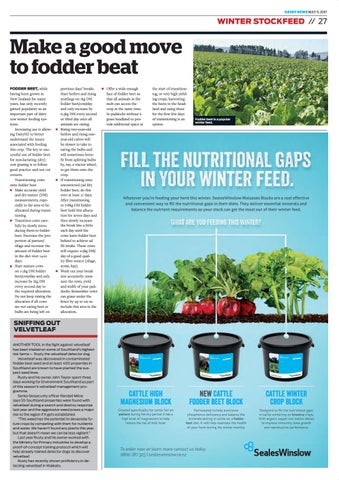s
DAIRY NEWS MAY 9, 2017
WINTER STOCKFEED // 27
Make a good move to fodder beat FODDER BEET, while having been grown in New Zealand for many years, has only recently gained popularity as an important part of dairy cow winter feeding systems. Increasing use is allowing DairyNZ to better understand the issues associated with feeding this crop. The key to successful use of fodder beet for non-lactating (dry) cow grazing is to follow good practice and not cut corners. Transitioning cows onto fodder beet ■■ Make accurate yield and dry matter (DM) measurements, especially in the area to be allocated during transitioning ■■ Transition cows carefully by slowly introducing them to fodder beet. Decrease the proportion of pasture/ silage and increase the amount of fodder beet in the diet over 14-21 days. ■■ Start mature cows on 1-2kg DM fodder beet/cow/day and only increase by 1kg DM every second day to the required allocation. Do not keep raising the allocation if all cows are not eating beet or bulbs are being left on
■■
■■
■■
previous days’ breaks. Start heifers and rising yearlings on 1kg DM fodder beet/cow/day and only increase by 0.5kg DM every second or third day once all animals are eating. Rising two-year-old heifers and rising oneyear-old calves will be slower to take to eating the bulbs and will sometimes benefit from splitting bulbs by, say, a tractor wheel, to get them onto the crop. If transitioning onto unrestricted (ad lib) fodder beet, do this over at least 21 days. After transitioning to 7-8kg DM fodder beet hold this allocation for seven days and then slowly increase the break line a little each day until the cows leave fodder beet behind to achieve ad lib intake. These cows still require 2-3kg DM/ day of a good quality fibre source (silage, straw, hay). Work out your break size accurately: measure the rows, yield and width of your paddocks. Remember cows can graze under the fence by up to 1m so include this area in the allocation.
■■
Offer a wide enough face of fodder beet so that all animals in the mob can access the crop at the same time. In paddocks without a grass headland to provide additional space at
the start of transitioning, or very high yielding crops, harvesting the beets in the headland and using these for the first few days of transitioning is an option.
Fodder beet is a popular winter feed.
Whatever you’re feeding your herd this winter, SealesWinslow Molasses Blocks are a cost effective and convenient way to fill the nutritional gaps in their diets. They deliver essential minerals and balance the nutrient requirements so your stock can get the most out of their winter feed.
SNIFFING OUT VELVETLEAF ANOTHER TOOL in the fight against velvetleaf has been trialled on some of Southland’s highest risk farms – Rusty the velvetleaf detector dog. Velvetleaf was discovered in contaminated fodder beet seed and at least 400 properties in Southland are known to have planted the suspect seed lines. Rusty and his owner John Taylor spent three days working for Environment Southland as part of this season’s velvetleaf management programme. Senior biosecurity officer Randall Milne says 55 Southland properties were found with velvetleaf during a search and destroy response last year and the aggressive weed poses a major risk to the region if it gets established. “This weed has the potential to devastate future crops by competing with them for nutrients and water. We haven’t found any plants this year, but that doesn’t mean we can be less vigilant.” Last year Rusty and his owner worked with the Ministry for Primary Industries to develop a proof-of-concept training protocol which will help already trained detector dogs to discover velvetleaf. Rusty has recently shown proficiency in detecting velvetleaf in Waikato.
Cattle high magnesium Block
NEW Cattle fodder beet block
Cattle winter crop Block
Created specifically for cattle fed on pasture during the dry period. It has a high level of magnesium to help reduce the risk of milk fever.
Formulated to help overcome phosphorus deficiency and balance the minerals lacking in cattle on a fodder beet diet. It will help maintain the health of your herd during the winter months.
Designed to fill the nutritional gaps in cattle wintering on brassica crops. With organic copper and iodine, shown to improve immunity, bone growth and reproductive performance.
To order now or learn more contact us today. 0800 287 325 | sealeswinslow.co.nz
